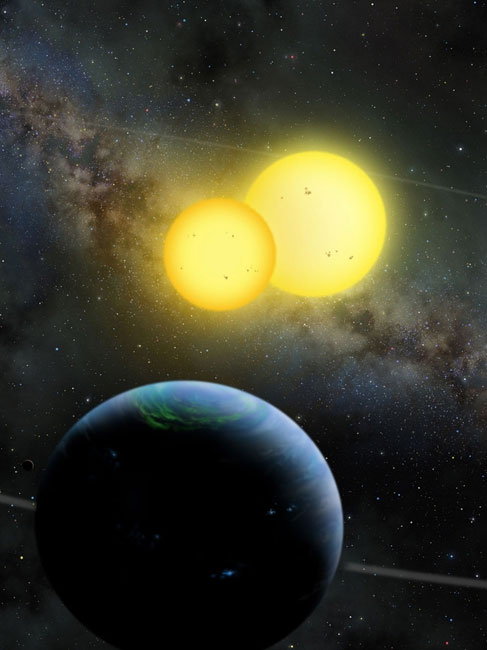Discover new form of planetary system
Based on NASA's Kepler Mission program data, astronomers announced the discovery of two new "double orbital" planets - where planets orbiting two stars (binary stars). This work demonstrates that planets around the two suns are not a rare exception, which is actually common to millions in the Milky Way.
Two newly discovered planets, known as Kepler-34b and Kepler-35b , are in the same form of gas as Saturn. Kepler-34b orbits two stars with our Sun with a trajectory of 289 days, a binary star orbiting each other in orbit and every 28 solar eclipses once. This eclipse allows us to accurately determine the size of each star. Kepler-35b revolves around a smaller binary star (80% and 89% above the Sun) with orbit of 131 days, the twin stars orbiting each other and every eclipse every 21 days. Both of these planets are in the constellation Swan, Kepler-34 is 4,900 light-years from Earth, Kerpler-35 is 5,400 light-years away, two of the most distant planets ever discovered.

Although it has long been predicted by science and science fiction, the existence of a "double orbital" planet orbiting a twin star is still uncertain, until the discovery of Kepler-16b. Like Kepler-16b, the two new planets also move across the double star surface, clearly confirming their existence. Only when Kepler-16b was discovered, many questions were raised about the dual orbital planetary nature - their trajectory, mass, radius, temperature . how? And most of the question is: Is Kepler-16b just a blessing? With the discovery of Kepler-34b and Kepler-35b, astronomers can now answer many related questions, and embark on a study of this completely new planet.
'We previously believed that the binary star's surroundings were too chaotic to form a double orbiting planet, but since these three planets have been discovered, we know the ability, or maybe, there is at least a few million such planets in the Milky Way series . " Leading the research group of 46 people, William Welsh from San Diego State University said.
Laurence Doyle from SETI Institute in Mountain View California said: 'With this report, the relative double orbiting planetary field - a new field of research - is being established.'
The discovery was made possible by three unique capabilities of the Kepler space telescope: extremely high accuracy, the ability to simultaneously observe 160,000 stars and continuously measure their brightness for a long time. In addition, the use of ground telescopes to measure the speed of stars is necessary to confirm the planets.'The search for dual orbiting planets is still in progress, we hope to continue to use the Kepler telescope for many years,' said Joshua Carter from the Harvard-Smithsonian Astrophysics Center. Cambridge, Massachusetts.
A double orbiting planet has two suns, instead of one. The distance from it to the binary star is constantly changing due to the orbital motion of the binary star, the amount of light that the planet receives is also significantly changed.'These planets may have a crazy climate that none of them have ,' says Jerome Orosz from San Diego State University. 'Each year four seasons will pass over and over again, along with with terrible temperature difference ".
Welsh added, 'The consequence of abnormal climate fluctuations on the movement of the atmosphere, and mainly the evolution on dual-orbiting orbiting planets, is the fascinating topic that we are only new to. shaking hands ".
- Discover new planetary system formed in the universe
- Discover planetary system like solar system
- Discover the solar system 7 planets
- Find a new planetary system containing 3
- Detecting inclined planetary system
- Strange planetary system has 3 'Venus'
- Discover the secret of Mercury formation
- Discover the planet's most planetary star
- Sun copies 'eat' many planets in the system
- New discovery of the solar system like the solar system
- The cradle of the solar system
- Discover planetary system with 7 copies of Earth!
 Van Allen's belt and evidence that the Apollo 11 mission to the Moon was myth
Van Allen's belt and evidence that the Apollo 11 mission to the Moon was myth The levels of civilization in the universe (Kardashev scale)
The levels of civilization in the universe (Kardashev scale) Today Mars, the sun and the Earth are aligned
Today Mars, the sun and the Earth are aligned The Amazon owner announced a secret plan to build a space base for thousands of people
The Amazon owner announced a secret plan to build a space base for thousands of people